
a.
whether the inequality
a.
Answer to Problem 36E
No
Explanation of Solution
Given:
The diagram below represents the number of students with brown eyes, brown hair or both.
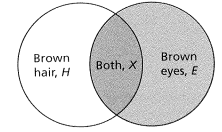
The inequality
Since here definite quantities are not given, so it is not possible just by looking at the diagram to determine whether the number of students with brown hair is greater than or equal to the number of students with brown eyes or not.
b.
whether the inequality
b.
Answer to Problem 36E
No
Explanation of Solution
Given:
The diagram below represents the number of students with brown eyes, brown hair or both.

Since it is not possible to determine whether the number of students with brown hair is more than the number of students with brown eyes or not.
So, it can’ t be guaranteed that on adding 10 to the number of students with brown hair, the sum will be greater than or equal to the number of students with brown eyes.
c.
whether the inequality
c.
Answer to Problem 36E
Yes
Explanation of Solution
Given:
The diagram below represents the number of students with brown eyes, brown hair or both.
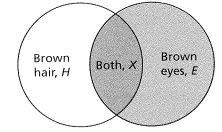
The inequality
Since from the given diagram it can be observed that, the set of students with both brown eyes and brown hair is contained in the set of students with brown hair.
Thus, the number of students with brown hair is greater than or equal to the number of students with both brown eyes and brown hair.
d.
whether the inequality
d.
Answer to Problem 36E
No
Explanation of Solution
Given:
The diagram below represents the number of students with brown eyes, brown hair or both.
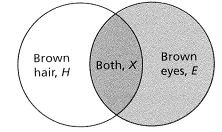
Since the number of students with brown hair is greater than or equal to the number of students with both brown eyes and brown hair.
So, it is guaranteed that on adding 10 to the number of students with brown hair, the sum will be greater than or equal to the number of students with both brown eyes and brown hair.
e.
whether the inequality
e.
Answer to Problem 36E
No
Explanation of Solution
Given:
The diagram below represents the number of students with brown eyes, brown hair or both.
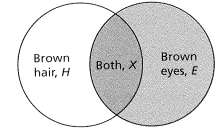
The inequality
But it is not true as there is a possibility that all the students with brown hair also have brown eyes. That is the case where set H is equal to the set X.
f.
whether the inequality
f.
Answer to Problem 36E
Yes
Explanation of Solution
Given:
The diagram below represents the number of students with brown eyes, brown hair or both.
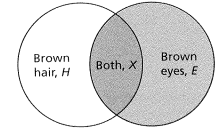
Since from part (c), the inequality
Chapter 2 Solutions
BIG IDEAS MATH Algebra 1: Common Core Student Edition 2015
- Please use the infinite series formula and specify how you did each step. Thank you.arrow_forward8) Solve the given system using the Gaussian Elimination process. 2x8y = 3 (-6x+24y = −6arrow_forward7) Solve the given system using the Gaussian Elimination process. (5x-4y = 34 (2x - 2y = 14arrow_forward
- 33 (a) (b) Let A(t) = = et 0 0 0 cos(t) sin(t) 0-sin(t) cos(t)) For any fixed tЄR, find det(A(t)). Show that the matrix A(t) is invertible for any tЄ R, and find the inverse (A(t))¹.arrow_forwardUse the infinite geometric sum to convert .258 (the 58 is recurring, so there is a bar over it) to a ratio of two integers. Please go over the full problem, specifying how you found r. Thank you.arrow_forwardH.w: Find the Eigen vectors for the largest Eigen value of the system X1+ +2x3=0 3x1-2x2+x3=0 4x1+ +3x3=0arrow_forward
- need help with 5 and 6 pleasearrow_forward1) Given matrix A below, answer the following questions: a) What is the order of the matrix? b) What is the element a13? c) What is the element a₁₁? 4 -1arrow_forward[25 points] Given the vector let v = ER² and the collection of vectors ε = E-{)·()}-{☹) (9)} = {(A)·(9)}· B: = and C = · {(6)·(})}· answer the following question. (a) (b) (c) (d) (e) verify Verify is a basis for R² and find the coordinate [] of under ε. Verify B is a basis for R2 and find the coordinate []B of ʊ Verify C is a basis for R2 and find the coordinate []c of under ε. under ε. Find the change-of-basis matrix [I]+B from basis B to basis ε, and EE+BUB Find the change-of-basis matrix [I]B+ε from basis Ɛ to basis B, and verify [U]B= [] B+EVEarrow_forward
- Explain the following terms | (a) linear span (b) dimension of vector space (c) linearly independent (d) linearly dependent (e) rank of matrix Aarrow_forward3. Let u = 3/5 √ = and = -4/5 -() Define V span{ū, }. (a) (b) (c) Show that {u, } is orthonormal and forms a basis for V. Explicitly compute Projy w. Explicitly give a non-zero vector in V+.arrow_forwardIs 1.1 0.65 -3.4 0.23 0.4 -0.44 a basis for R3? You must explain your answer 0arrow_forward
 Algebra and Trigonometry (6th Edition)AlgebraISBN:9780134463216Author:Robert F. BlitzerPublisher:PEARSON
Algebra and Trigonometry (6th Edition)AlgebraISBN:9780134463216Author:Robert F. BlitzerPublisher:PEARSON Contemporary Abstract AlgebraAlgebraISBN:9781305657960Author:Joseph GallianPublisher:Cengage Learning
Contemporary Abstract AlgebraAlgebraISBN:9781305657960Author:Joseph GallianPublisher:Cengage Learning Linear Algebra: A Modern IntroductionAlgebraISBN:9781285463247Author:David PoolePublisher:Cengage Learning
Linear Algebra: A Modern IntroductionAlgebraISBN:9781285463247Author:David PoolePublisher:Cengage Learning Algebra And Trigonometry (11th Edition)AlgebraISBN:9780135163078Author:Michael SullivanPublisher:PEARSON
Algebra And Trigonometry (11th Edition)AlgebraISBN:9780135163078Author:Michael SullivanPublisher:PEARSON Introduction to Linear Algebra, Fifth EditionAlgebraISBN:9780980232776Author:Gilbert StrangPublisher:Wellesley-Cambridge Press
Introduction to Linear Algebra, Fifth EditionAlgebraISBN:9780980232776Author:Gilbert StrangPublisher:Wellesley-Cambridge Press College Algebra (Collegiate Math)AlgebraISBN:9780077836344Author:Julie Miller, Donna GerkenPublisher:McGraw-Hill Education
College Algebra (Collegiate Math)AlgebraISBN:9780077836344Author:Julie Miller, Donna GerkenPublisher:McGraw-Hill Education





